Nonlinear Dynamics of an Electrorheological Sandwich Beam with Rotary Oscillation
Abstract
The dynamic characteristics and parametric instability of a rotating electrorheological (ER) sandwich beam with rotary oscillation are numerically analyzed. Assuming that the angular velocity of an ER sandwich beam varies harmonically, the dynamic equation of the rotating beam is first derived based on Hamilton′s principle. Then the coupling and nonlinear equation is discretized and solved by the finite element method. The multiple scales method is employed to determine the parametric instability of the structures. The effects of electric field on the natural frequencies, loss factor, and regions of parametric instability are presented. The results obtained indicate that the ER material layer has a significant effect on the vibration characteristics and parametric instability regions, and the ER material can be used to adjust the dynamic characteristics and stability of the rotating flexible beams.
1. Introduction
The dynamics of rotating flexible beams have been the subject of extensive research due to a number of important applications in engineering such as manipulators, helicopters, turbine blades, and so forth. Much research about the dynamic modeling and vibration characteristics of fixed-shaft rotating beams has been published in recent decades. Chung and Yoo [1] investigated the dynamic characteristics of rotating beams using finite element method (FEM) and obtained the time responses and distribution of the deformations and stresses at a given rotating speed. The nonlinear dynamics of a rotating beam with flexible root attached to a rotating hub with elastic foundation has been analyzed by Al-Qaisia [2]. He discussed the effect of root flexibility, hub stiffness, torque type, torque period and excitation frequency and amplitude on the dynamic behavior of the rotating beam-hub. Lee et al. [3] investigated divergence instability and vibration of a rotating Timoshenko beam with precone and pitch angles. The nonlinear modal analysis of a rotating beam has been studied by Arvin and Bakhtiari-Nejad [4]. The stability and some dynamic characteristics of the nonlinear normal modes such as the phase portrait, Poincare section, and power spectrum diagrams have been inspected. But most research to date has examined only the effects of steady velocity on the vibration characteristics of the flexible beam, without considering the dynamic characteristics of speed variation of beams. Rotating flexible beams with variable speeds, such as manipulators, demonstrate complex dynamic characteristics because of changes in angular velocity. The beam can suffer from dynamic instability under certain movement parameters. Therefore, the vibration stability of flexible beams with variable angular velocity has attracted increasing attention in recent years. Abbas [5] studied the dynamics of rotating flexible beams fixed on a flexible foundation, and using FEM analyzed the effects of rotation speed and flexible foundation on the static buckling load and region of vibration instability. Young and Lin [6] investigated the parametrically excited vibration of beams with random rotary speed. Sinha et al. [7] analyzed the dynamic stability and control of rotating flexible beams with different damping coefficients and boundary conditions. Chung et al. [8] studied the dynamic stability of a fixed-shaft cantilever beam with periodically harmonic swing under different swing frequencies and speeds. Turhan and Bulut [9] studied the vibration characteristics of a rotating flexible beam with a central rigid body under periodically variable speeds, and simulated the dynamic stability of the system under different movement parameters. Nonlinear vibration of a variable speed rotating beam has been analyzed by Younesian and Esmailzadeh [10]. They investigated the parameter sensitivity and the effect of different parameters including the hub radius, structural damping, acceleration, and the deceleration rates on the vibration amplitude.
Electrorheological (ER) materials are a kind of smart material whose physical properties can be instantaneously and reversibly controlled with the application of an electric field. These unusual properties enable ER materials to be employed in numerous potential engineering applications, such as shock absorbers, clutch/brake systems, valves and adaptive structures. One of the most commonly studied ER structures is the ER sandwich beam, in which an ER material layer is sandwiched between two containing surface layers [11]. These sandwich structures have the adaptive control capability of varying the damping and stiffness of the beam by changing the strength of the applied electric field. Since Gandhi et al. [12] first proposed the application of ER fluids to adaptive structures, much has been achieved in the vibration control of beams [13–15]. More recently, the dynamic stability problems of ER sandwich beams have attracted some attention. Yeh et al. [16] studied the dynamic stability problem of an ER sandwich beam subjected to an axial dynamic force. They found that the ER core had a significant effect on the dynamic stability regions. Yeh and Shih [17] investigated the critical load, parametric instability, and dynamic response of a simply supported ER adaptive beam subjected to periodic axial force. However, research into the application of ER materials to vibration control of rotating motion beams is rare. In our previous work [18], the feasibility of applying ER fluids to the vibration control of rotating flexible beams was discussed. Results demonstrated that the vibration of the beam caused by the rotating motion at different rotation speeds and acceleration could be quickly suppressed by applying electric fields to the ER material layer. When the angular velocity of the rotating ER sandwich beam is variable, the rotating beam would suffer from parametric instability at some critical movement parameters. In order to successfully apply ER materials to the vibration control of rotating beams and optimize the control effects, it is needed to investigate the nonlinear dynamic characteristics and vibration stabilities of the rotating ER sandwich beam.
In this paper, the dynamic characteristics and parametric instability of a rotating ER sandwich beam with rotary oscillation is investigated. Assuming the ER sandwich beam to rotate around a fixed axis with time-varying harmonic periodic motion, the rotating ER sandwich beam is regarded as a parametrically excited system. Based on Hamilton’s principle and finite element method (FEM), the governing equations of the rotating beam are obtained. The multiple scales method is employed to determine the regions of instability for simple and combination resonances. The effects of electric field on the natural frequency, loss factor, and regions of parametric instability are investigated. The results of the stability analysis are verified by investigating the time responses of the ER sandwich beam.
2. Properties of ER Fluids
ER fluids behave as Newtonian fluids in the absence of an electric field. On application of an electric field, their physical appearance changes to resemble a solid gel. However, their rheological response changes before and after the yield point. Due to this difference in rheological behavior before and after the yield point, the rheology of ER fluids is approximately modeled in pre-yield and post-yield regimes (Figure 1). The pre-yield regime can be modeled by a linear viscoelastic model, and the post-yield regime be modeled by the Bingham plastic model.

3. Finite Element Modeling of Rotating ER Sandwich Beams
Because ER materials exhibit linear shear behavior at small strain levels similar to many visco-elastic damping materials, it is found that the models developed for the viscoelastically damped structures were potentially applicable to ER materials beams [20]. So in the present study, the finite element model for a rotating beam with a constrained damping layer [21, 22] is adopted to model the rotating ER sandwich beam.
3.1. Basic Kinematic Relationships of the Rotating Beam
The structure of an ER sandwich beam is shown in Figure 2. The ER material layer is sandwiched between two elastic surface layers. The beam with a length L and width b rotates in a horizontal plane at an angular velocity about the axis Y.
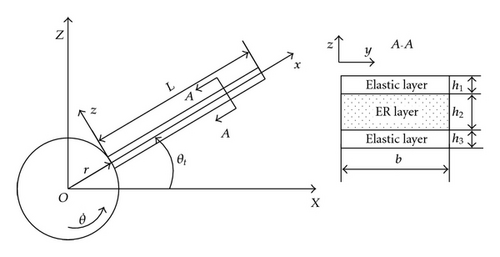
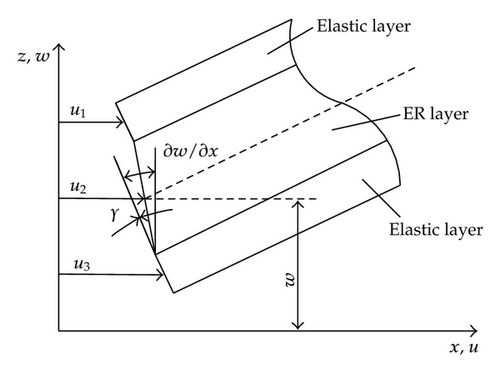
3.2. Governing Equations
3.3. Finite Element Discretization
4. Stability Analysis
Equation (3.18) represents a typical parametrically excited system because the last term on its left-hand side is a periodic function of time. When the system parameters reach special resonance conditions, the rotating beam will suffer divergence instability [24]. The determination problem of these conditions is called dynamic stability analysis. In this section, stability of the solutions of (3.18) will be studied by multiscale method.
(a) Combination Resonance of Sum Type If the variation frequency approaches the sum of any two natural frequencies of the system, summation parametric resonance may occur. The nearness of to (ωp,R + ωq,R) can be expressed by introducing a detuning parameters σ defined by
Substituting (4.7) into (4.6), the condition required to eliminate secular terms in (4.6) can be obtained as
From the condition that nontrivial solutions of (4.8) should be bounded, the boundaries of the unstable regions in this case are given by [9, 22]
When p = q, (4.9) can be simplified into the critical condition for instability of order n harmonic resonance,
(b) Combination Resonance of Difference Type When the excitation frequency varies around the difference between the natural frequencies at orders p and q, this phenomenon is called the combination resonance of difference type. Its boundary condition of instability can be obtained by changing the sign of ωi in the situation above. The boundary curve of the corresponding stability and instability curves is
(c) No-Resonance Case Consider the case that the excitation frequency is far away from (ωp,R ± ωq,R) for all possible positive integer values of p and q. In this case, the condition required to eliminate the secular terms in (4.6) is
Because there does not exist the case where is simultaneously near (ωp,R + ωq,R) and (ωp,R − ωq,R), there is no unstable solution for (4.7). Hence the system is said to be always stable when is away from (ωp,R ± ωq,R).
5. Numerical Simulation and Discussion
To validate the reliability of the calculation methods in this paper, we first assumed that the angular speed of the rotating ER sandwich beam and regarded it as a static cantilever beam. The structural and material parameters of the beam in [19] were used to calculate the natural frequencies and modal loss factors for the first five orders when the electric field intensity E = 3.5 kV/mm. The results are shown in Table 1. We can see from the table that although the natural frequencies at each order obtained through the method in this paper are slightly higher than that obtained from the Mead-Markus modeling method in [19], the difference is minimal. The loss factors obtained through the two methods are basically the same. We also used the geometric and material parameters of rotating beams at the active restraint damping layer in [26] to calculate the natural frequencies and modal damping ratio for the first two orders under different rotation speeds (Table 2) and found that the result obtained from the method in this paper is almost the same as that obtained from [26].
| Mode | Natural frequency f (Hz) | Loss factor η | ||
|---|---|---|---|---|
| Present | Ref. | Present | Ref. | |
| 1 | 10.011 | 10.005 | 0.00393 | 0.00395 |
| 2 | 40.091 | 40.051 | 0.00507 | 0.00512 |
| 3 | 89.125 | 89.028 | 0.00459 | 0.00461 |
| 4 | 152.926 | 152.702 | 0.00336 | 0.00339 |
| 5 | 236.396 | 235.761 | 0.00244 | 0.00250 |
| Angular velocity | Natural frequency | Modal damping ratio | |||
|---|---|---|---|---|---|
| (r.p.m) | f1 (Hz) | f2 (Hz) | |||
| 0 | Ref. | 20.15 | 104.0 | 0.0382 | 0.0235 |
| Present | 20.14 | 103.9 | 0.0384 | 0.0233 | |
| 600 | Ref. | 20.58 | 106.8 | 0.0365 | 0.0220 |
| Present | 20.53 | 106.6 | 0.0366 | 0.0222 | |
| 1000 | Ref. | 21.20 | 111.2 | 0.0340 | 0.0201 |
| Present | 21.17 | 111.1 | 0.0340 | 0.0204 | |
| Parameters of beam geometry | L = 300 mm, b = 20 mm, h1 = h3 = 0.5 mm, h2 = 2 mm |
| Elastic layer properties (Al) | ρ1 = ρ3 = 2700 kg/m3, E1 = E3 = 70 Gpa |
| ER fluid properties [27] | ρ2 = 1200 kg/m3, G* = 50000E2 + (2600E + 1700)i |
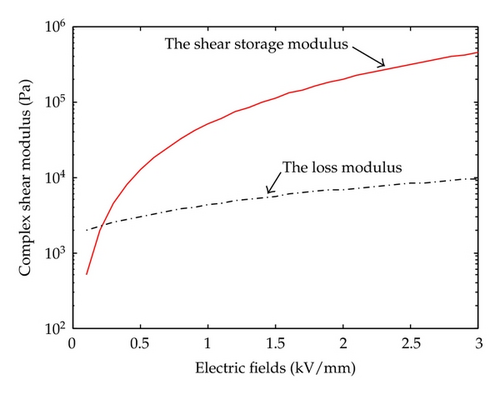
Comparisons of the natural frequencies and loss factors of ER sandwich beams with different rotating speed are shown in Figures 5 and 6, respectively. Figure 5 shows the effects of electric field strength on the first three natural frequencies. It is observed that the increment of the electric field strength increases the natural frequencies of the ER sandwich beam at different rotation speeds. Thus, the stiffness of the rotating beam increases with the strength of the applied electric field. Figure 6 illustrates the effect of electric field strength on the loss factors. At all rotation speeds, the loss factor first increases as the electric field strength increases. But the loss factor declines with the strength of the electric field when the electric field strength exceeds 0.5 kV/mm. This trend is very obvious in lower modes and less evident in higher modes. Figures 5 and 6 also demonstrate that the natural frequency increases and the loss factor decreases with an increase in rotating speed. That is because the stiffness of the rotating ER beam increases with rotating speed, whereas its damping decreases with rotating speed. Thus the natural frequencies and loss factors of the rotating ER beam can be altered by varying the strength of the applied electric field.
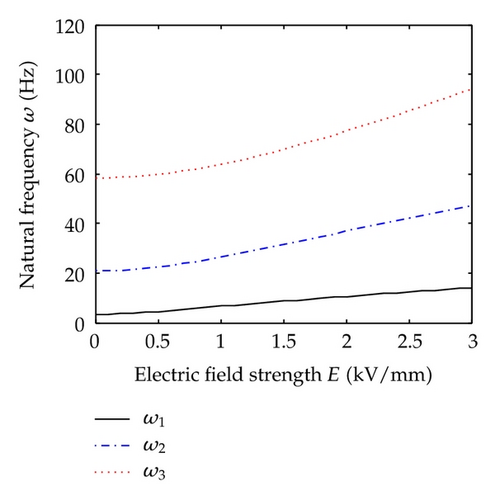
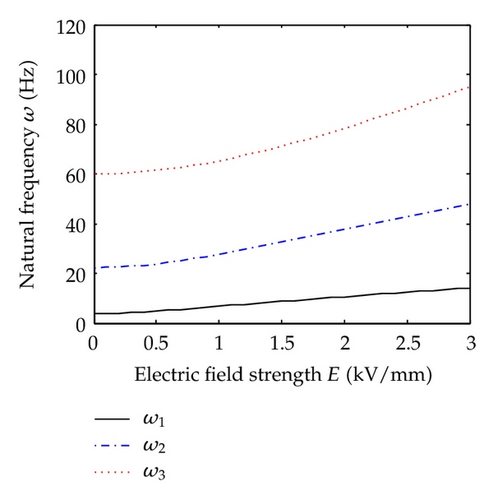
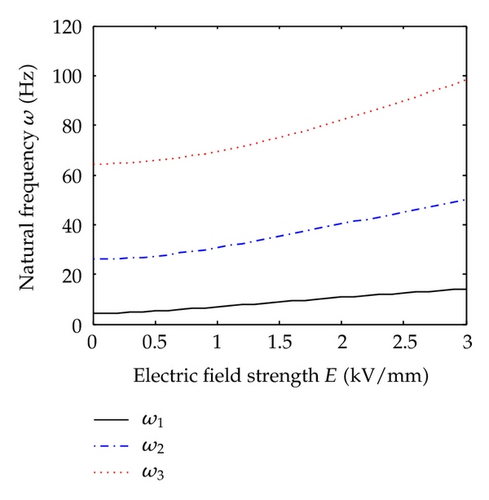
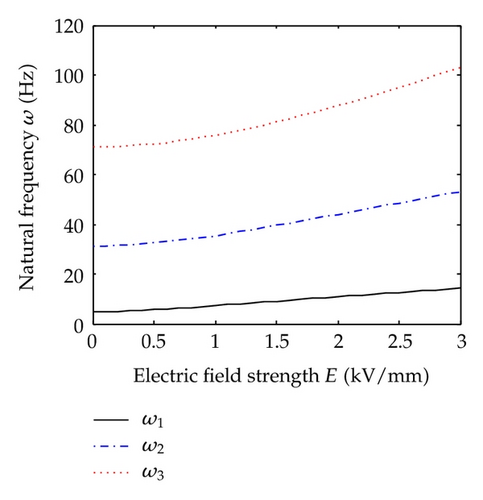
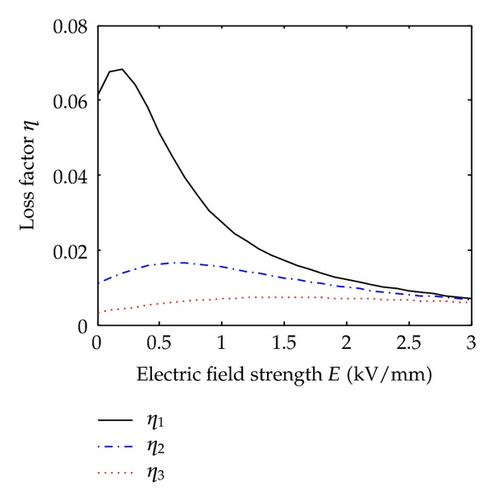
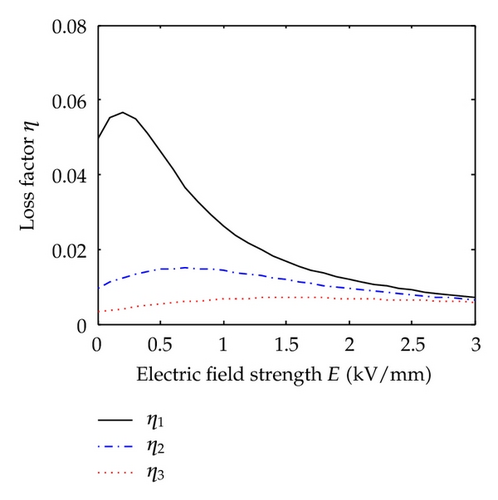
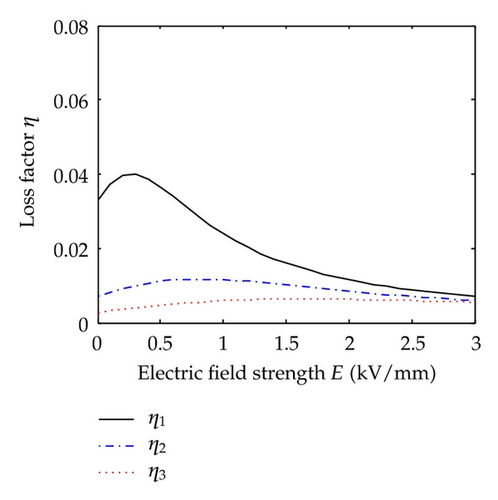
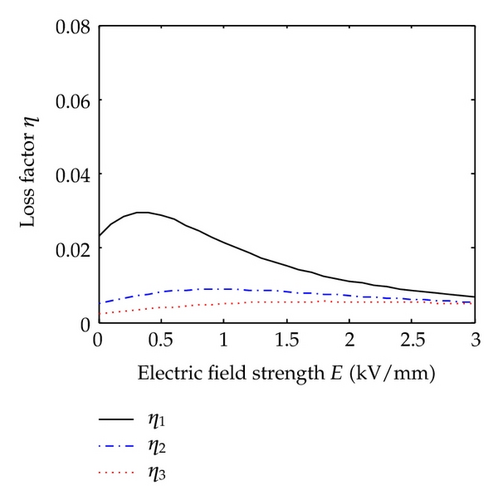
The multiple scale method was used to obtain the parametric instability region of the rotating ER sandwich beam with periodically variable angular velocity. The effects of electric field strength on the region of parametric instability are shown in Figure 7. Figures 7(a) and 7(b) illustrate the instability regions for the first and second order parametrically excited resonance, respectively, and Figures 7(c) and 7(d) are the instability regions for parametrically excited combination resonance of sum and difference types. It is noted that increasing the electric field strength will increase the excitation frequency so that the unstable regions shift to the right. The critical maximal rotating speed (i.e., the maximal rotating speed when parametric instability occurs) increases and the width of unstable region decreases with an increase in the strength of the electric field. Thus increasing the strength of the applied electric field not only moves the region of instability to a higher frequency, but also reduces the width of the region. That is, increasing the electric field strength will increase the stability of the beam.
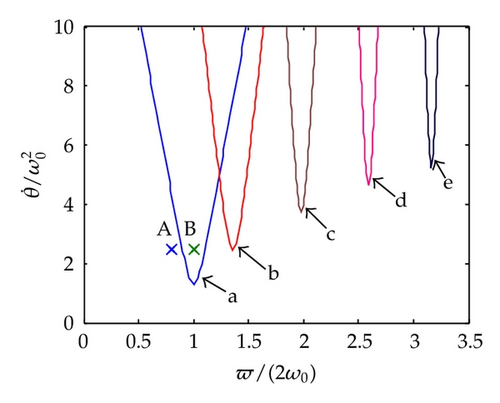
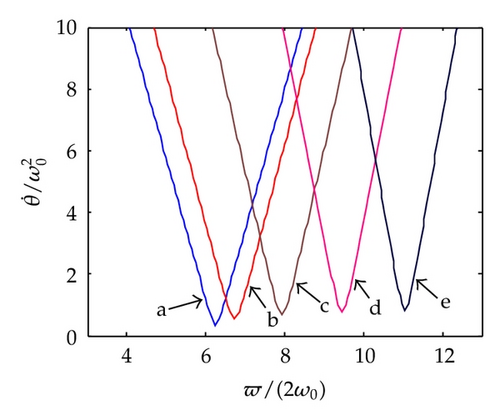
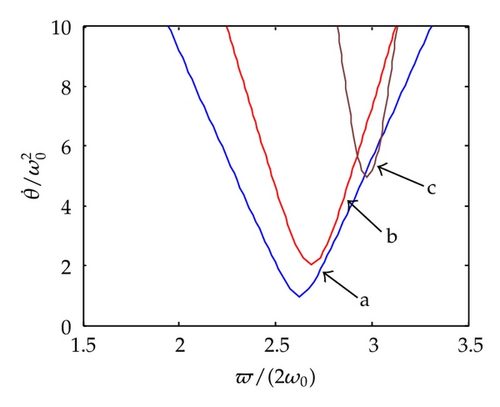
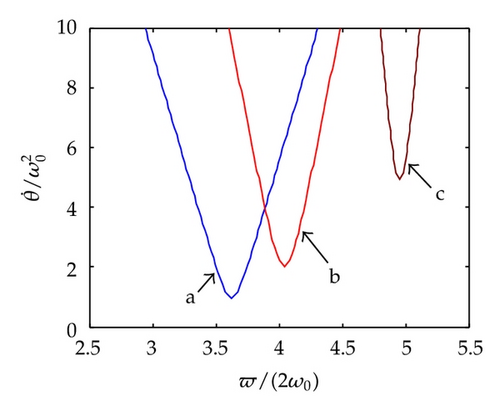
The results of the stability analysis can be verified by investigating the time responses for points A and B in Figure 7(a). The time responses for the transverse displacement are computed at the free end of the ER sandwich beam by (3.18) using the fourth-order Runge-Kutta method. The co-ordinates of points A and B in Figure 7(a) are (0.8, 3) and (1, 3). As shown in Figure 7(a), point A is in the stable region and point B is in the unstable region without an applied electric field, whereas points A and B are both in the stable region when the electric field strength E = 0.5 kV/mm.
Comparisons of the time responses of points A and B without electric field are shown in Figure 8. The time response for point A, as shown in Figure 8(a), is bounded by a limited value. However, for point B, which is within the unstable region, the amplitude of the time response increases with time, as illustrated in Figure 8(b). Figure 9 shows the time responses for points A and B when the electric field strength E = 0.5 kV/mm. It is demonstrated that points A and B are both stable because the time responses are bounded. Therefore, it is verified that the stability results of Figure 7(a) agree well with the behavior of the time responses in Figures 8 and 9.

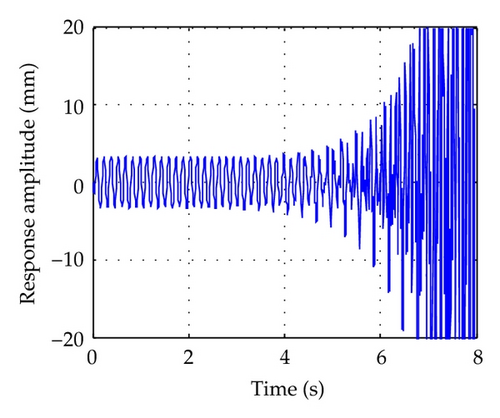
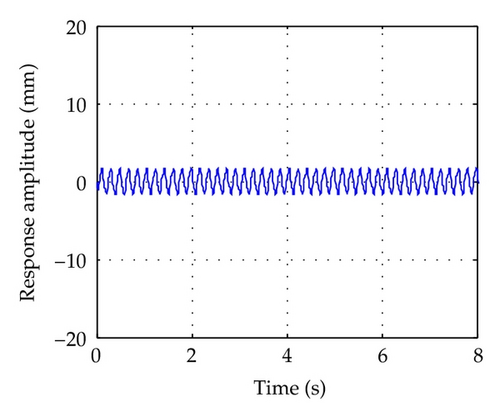
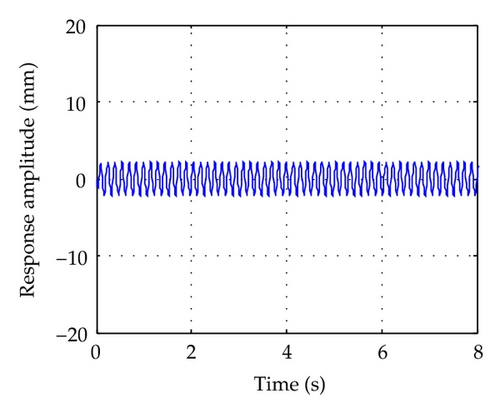
6. Conclusion
The dynamic characteristics and parametric instability of rotating ER sandwich beams with a periodically variable angular velocity were studied using FEM and a multi-scale method. The effects of electric field on the natural frequency, loss factor, and regions of parametric instability were investigated. When the strength of the electric field is increased, the stiffness of the ER sandwich beam increases at different rotation speeds and the instability region of the rotating beam moves toward the high-frequency section. The unstable regions narrow with an increase in the strength of the electric field, while the maximum critical angular speed required for the beam to have parametric instability increases as electric field increases. Hence the vibration characteristics and dynamic stability of rotating ER sandwich beams can be adjusted when they are subjected to an electric field. It was demonstrated that the ER material layer can be used to improve the parametric instability of rotating flexible beams.
Acknowledgments
This work was supported by the National Natural Science Foundation of China (11172100 and 51075138), and the Scientific Research Fund of Hunan Provincial Education Department of China (10A021).




